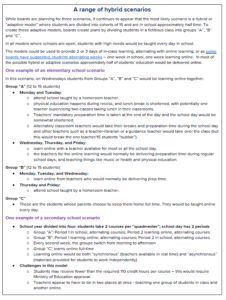School board planning for fall hindered by lack of clarity
No plan in place to support families
Ontario’s school board directors must provide their school re-opening plans to the province by August 4th. The plans must ensure that school staff not only are ready for several possible scenarios, but that they are prepared to pivot quickly if the COVID situation changes.
The Ministry of Education has outlined three scenarios to be considered for opening schools in the fall:
- students returning to school full-time, with enhanced public health protocols (including things like physical distancing “bubbling” students into groups of 15);
- a so-called hybrid or adaptive model where students learn part-time at school and part-time online; and/or
- schools remaining closed with students doing all their learning remotely.
A number of directors say they have been hampered by a lack of clarity from the province, and they are concerned that they may spend weeks making plans that will not be approved by the Minister.
Collaborating to develop workable plans
Any of the various scenarios that boards are planning (see box) will require flexibility from the Ministry of Education, school board staff, and teacher and support staff unions. It will also require flexibility from families and students as they may be required to manage as much as half of students’ learning time outside of school.
People for Education and others, including the Ontario Human Rights Commission, have called on the Minister to convene a Task Force or Partnership Table to ensure that those with experience and expertise can work together to problem solve, test ideas, and create an effective and workable plan. Organizations like the Ontario Secondary School Teachers’ Federation have provided their own guidelines for school re-opening. However, thus far the Minister of Education has declined to bring together at one table, leaders from organizations representing directors of education, principals, teachers, support staff, students, faculties of education, health, municipal services, and early childhood education.
According to the World Bank, some students will lose as much as six months of school, and these lost months, combined with lower levels of learning, and an increased potential for dropping out from school will have long-term social and economic consequences.
Families need support
Despite the fact that some form of distance learning will probably continue into the fall, none of the possible scenarios and none of the education funding recently announced by the province for technology and mental health supports, is focused on supporting families or students at home. There are also significant gaps in supports for childcare.
The experience from March to June has shown that the impact of distance learning is not experienced equally. Closed schools exposed and amplified families’ widely differing capacities to support their children’s learning at home, and it may exacerbate existing gaps in the long-term. Children and young people in families who are already struggling financially, families where parents must work outside the home, and families dealing with a range of stresses are in danger of falling further behind.
While increased childcare supports will help some young children and families, students from 8 to 18 cannot be asked to manage their own online learning, and their parents cannot be asked to stay home with them. As Ontario moves to Stage 3, and more businesses re-open, many families will be left in the lurch for home supervision that can respond to any of the possible education scenarios.
Cooperation and funding required from three levels of government to
There are possible solutions. But they will require funding from the federal government to move beyond the financial crisis, to recognize the human crisis caused by COVID.
With support from the federal government, and cooperation from provinces and municipalities, students could be supported in places such as community centres and libraries on the days they are not in school. They would still be taught by teachers online, but students would be supervised and supported by professional staff like child and youth workers, social workers, or graduate students.
In this scenario, students would have somewhere to go every day; they would be supported in their learning; and they would be much less likely to fall behind. Programs such as Pathways to Education have shown that when students are supported by adults such as child and youth workers, they are more likely to succeed.
The Canadian Constitution prevents the federal government from directly funding or being involved in provincial education. But under this model, the federal government would be supporting families and young people outside of school. It would be a federal investment in the country’s next generations, and it would help to ensure that all – not just some – children and young people will be supported through this pandemic and have the bright futures that they all deserve.
Billions of dollars have been spent to offset the financial crisis; now it is time to focus on Canada’s young people. We cannot know what the pandemic will bring this fall or winter, but we can ensure that resources are in place to support students and to provide certainty in uncertain times.
